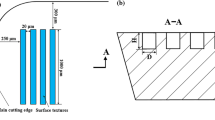Abstract
The reversion of Fe-18.5 Ni-0.52 C tempered martensitic steel to austenite under shear was used to study the formation of discontinuous chips by orthogonal cutting. For certain combinations of cutting speed, depth of cut, and tool rake angle, chips with bands of reverted austenite along their sheared edges were formed. Tensile tests on the same material exhibited transformed austenite on the specimen fracture surfaces for tests conducted below 200°C. Metal cutting theory predicts that continuous plastic deformation during chip formation cannot heat the material to its reversion temperature. Analysis of the machine-sample interaction before chip separation shows that adiabatic instability can occur, resulting in localized shearing and a temperature rise to at leastA s. Only those chips which are heated during continuous deformation to temperatures between 100° and 200°C undergo adiabatic instability and reversion.
Similar content being viewed by others
References
P. G. Winchell: Ph.D. Thesis, Department of Metallurgy, M.I.T., Cambridge, Mass., 1958, pp. 72–76.
R. W. Rhode:Acta Met., 1970, vol. 18, pp. 903–13.
R. J. Russell: Ph.D. Thesis, Department of Metallurgy, Purdue University, Lafayette, Ind., 1967.
R. F. Recht:Trans. ASME, J. Appl. Mech., 1964, Paper no. 63, WA-67, pp. 189-93.
M. Field and M. E. Merchant:Trans. ASME, 1949, vol. 71, pp. 421–30.
N. H. Cook, I. Finnie, and M. C. Shaw:Trans. ASME, 1954, vol. 76, pp. 153- 62.
W. B. Palmer:J. Mech. Eng. Sci., 1967, vol. 9, pp. 1–10.
D. C. Wallace, P. H. Sidles, and G. C. Danielson:J. Appl. Phys., 1960, vol. 31, p. 168.
W. B. Palmer and M. S. M. Riad: Proc. 8th Inter. Machine Tool Design and Research Conf., Sept. 1967, University of Manchester, pp. 259-79.
R. G. Fenton and P. L. B. Oxley:Proc. Instn. Mech. Engrs., 1968-69, vol. 183, part 1, pp. 417–28.
J. H. WeinenTrans. ASME, 1955, vol. 77, pp. 1331–38.
E. G. Leowen and M. C. Shaw:Trans. ASME, 1954, vol. 76, pp. 217–21.
R. W. Rhode and R. A. Graham:Trans. TMS-AIME, 1969, vol. 245, pp. 2441- 45.
M. J. Roberts and W. S. Owen:Met. Trans., 1970, vol. 1, pp. 3203–13.
G. Y. Chin, W. F. Hosford, and W. A. Backofen:Trans. TMS-AIME, 1964, vol. 230, pp. 437–49.
J. C. Lemaire: M.S. Thesis, Department of Metallurgy and Materials Science, M.I.T., Cambridge, Mass.
H. S. Carslaw and J. C. Jaeger:Conduction of Heat in Solids, 2nd ed., p. 80, Clarendon Press, Oxford, 1959.
Author information
Authors and Affiliations
Additional information
Formerly National Science Foundation Trainee, Massachusetts Institute of Technology, Cambridge, Mass.
Rights and permissions
About this article
Cite this article
Lemaire, J.C., Backofen, W.A. Adiabatic instability in the orthogonal cutting of steel. Metall Trans 3, 481–485 (1972). https://doi.org/10.1007/BF02642052
Received:
Published:
Issue Date:
DOI: https://doi.org/10.1007/BF02642052




